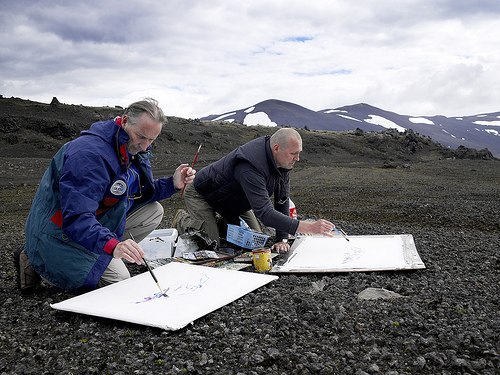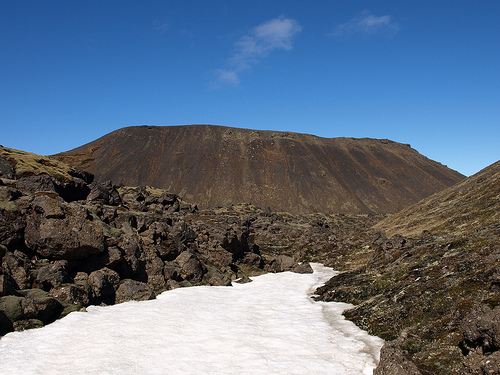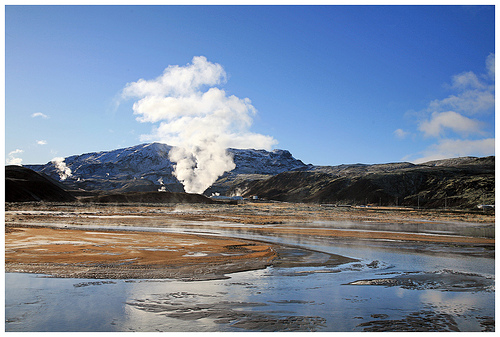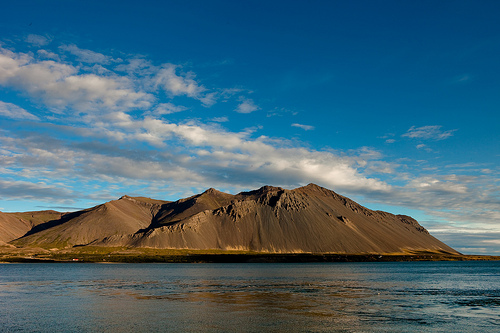Ari Trausti Guðmundsson is a prolific writer whose collection of short stories ‘Vegalínur’ (“Road Lines”) received the Halldór Laxness Literature Prize in 2002. Perhaps more so than his fiction and poetry, however, the trained geophysicist and mountaineer is known for the tens of books that he has written about Iceland, its nature and rich geology. After flipping through his most recent output in this genre, ‘Summit – 100 Mountain Hikes,’ which is, as the title suggests, a book detailing 100 hikes in Iceland, we thought, ‘This is impressive. It’s time to drop Ari Trausti a line…’
Grapevine last spoke to you just before this summer’s presidential elections, which saw incumbent Ólafur Ragnar Grímsson re-elected to a record fifth term. How do you feel about the whole experience of running? Have you had time to reflect on it all?
Yes, I have. The experience was a very positive one. My arguments for a new person in office as well as for how the president should conduct his work were well received. My wife, María, and I travelled all over Iceland, meeting thousands of people who were genuinely interested in the interaction between this directly elected spokesperson of society on one hand and people or politics on the other.
Surveys and later research by social scientists show that two viewpoints amongst voters heavily affected the election outcome. One was a voter’s view towards the acting government. If you supported the government you voted against Ólafur Ragnar. If you were against the government, you voted for him. The other was the notion that you had to vote for one of the two people leading in the polls, even if you thought that some of the other candidates were better suited for the job. Surveys revealing these facts indicate that I had far more support from voters than the election results suggest. Numerous calls, e-mails and personal statements that I have since received also lead me to conclude that I have to consider whether or not to run again. María and I aren’t going to make any decisions now, but we will have to one day.
To conclude: I don’t think that there was enough participation in the elections and I hope we will never again see voter turnout below 70%. A mandate with some 85,000 votes out of a contingent of 230,000 voters is not solid enough ground.
TOO MANY PEAKS TO COUNT
As an avid hiker for many years, do you find that reflecting is something best done at the top of a mountain?
I started hiking and mountaineering some 45 years ago, gradually putting more and more emphasis on technical climbing and high-altitude mountaineering. However, hiking has always played a big part in such activities as well as my leisure time. Hiking is good for your soul, at least mine. It puts you in a close contact with the environment and it strengthens your body and allows you to savour nature. It also enables you to think freely because aside from maybe seeking the best way forward or marvelling at some sights, you have ample time to let the mind wander and I get many good ideas while hiking.
Quite often the summit is not the main goal of a hike or climb and sometimes it doesn’t involve a summit. But summits are nice, and I have been lucky enough to make it to the top of a number of otherwise unclimbed ones in Iceland.
Your most recent book, ‘Summit – 100 Mountain Hikes,’ published in English last year, suggests that you’ve topped at least 100 summits in Iceland. How do you make time for all of these mountains? Do you spend more time a few hundred metres up than you do at ground level?
I don’t know how many mountains I have scaled in the last 45 years, but the number isn’t what’s important. I topped a number of these 100 while working as a guide from approximately 1967–1990 and others through freelance work and assignments over the last 25 years, such as hosting TV programmes. For the most part, however, I have been a family man with a good number of chores to do on the ground level.
Are there many left for
you to conquer?
Yes, there are, especially abroad, but that doesn’t bother me. There are some summits that I do not want to scale, as they are uninteresting or they are too time-consuming, but in any case, it would be impossible to climb them all, as there are just far too many. I am very happy with what I have gotten away with.
A few words on the term ‘conquer’: I think it has an aura of disrespect. Man does not conquer nature. A mountain always has the upper hand even after you’ve scaled it. It will remain almost unchanged long after you’ve been there. Man has to learn how to be a humble part of nature, to treat it as an equal, not as something to be conquered—something that has been falsely stated in books and by important people through ages.
Are there some that you
keep coming back to?
In general no, because I try to seek new experiences but of course you can get that by scaling the same mountain by different routes or in different seasons. In addition, hiking and climbing require practice and you tend to use mountains that are close to your home for such purposes. I have often stood on top of the same mountains, but am still adding new ones to my bank of experience. An absolute favourite? No.
INCREASING TRAFFIC
A woman died last month while hiking Esja, a mountain that gets so much traffic that some have likened its main footpath to Laugavegur, downtown Reykjavík’s main drag. Is it a dangerous mountain? Was this a freak accident?
Esja is a big mountain with dozens of routes, which can be especially tough during the winter season. One way to decrease strain on the two to three main hiking routes is for more people to wander to other nearby mountains, most of which are also quite tough for 6–7 months of the year. I would also advise people to gain hiking and mountaineering experience in small and adequate steps.
I cannot comment on the painful accident because I do not know the circumstances. Sadly, since 1980, we have had a number of deaths or serious accidents occurring amongst mountaineers. In some cases, it is hard to see what could have prevented an accident but in other cases poor judgment, lack of experience or equipment or a serious mistake is at fault. As the number of accidents is prone to increase with more people on the move, the need for more information and education grows. And this has been met by courses, written material and webpages. Still, there is not enough awareness at hand and I regularly meet hikers on my tours that are poorly equipped or haven’t checked the weather forecast.
What kinds of precautions should people take before venturing into Iceland’s often-unforgiving nature?
Take one to two day weather forecasts seriously, seek advice if uncertain about something, let others know where you are heading, learn about snow avalanches and very basic mountaineering skills, use basic equipment according to season, have some spare clothing in the backpack, fuel consistently (eat and drink!) and don’t be afraid to turn back.
I have written newspaper articles almost every year now to remind people about what I think are two of the most serious flaws: not using proper crampons and ice axes for winter ascents and not properly knowing how to use ropes and harnesses on glaciers.
Most mountains in Iceland are distinctively lacking in footpaths. This raw element is undoubtedly part of the beauty, but it probably comes at a cost too. Do you think there is real danger of hikers trampling and destroying precisely what makes the experience special?
Yes, in some cases. This stems from the fact that the organisation of hiking, mountaineering and preservation of mountain areas is very scarce. Like so many aspects of tourism and travelling in Iceland, hiking, like off-roading, has for decades been a free zone, a haphazard jungle expedition, more or less an open field for entrepreneurs.
With increased traffic, this has to be addressed and requires investment like the funds now allocated by the government to improve “hot spots.” But at the same time, we have to watch out for the tendency to be too restrictive.

THREE RECOMMENDED SUMMER HIKES NOT FAR FROM REYKJAVÍK
By Ari Trausti Guðmundsson

1. STÓRA-KÓNGSFELL (602 m)
From a small parking lot in front of the Eldborg crater close to the Bláfjöll skiing area, follow a path between the crater and a small mountain called ‘Drottning.’ On the other side of the mountain, you cross a lava flow to the bigger ‘Stóra-Kóngsfell.’ The path is hard to find, but the crossing can be made safely if you walk carefully. Follow the base of the mountain until you reach a cairn, which marks a path that winds its way upwards across scree-slopes to the top. This hike can be done in two to three hours, both ways. It is a short and moderate, but rewarding outing.

2. THE HENGILL CIRCUT (805 m)
Start in the small valley behind the Hellisheiði Geothermal Power Plant. Directions there lead you to a parking lot below the Sleggjubeinsskarð pass. The route, which is marked by wooden pegs, takes you to this pass, into Innstidalur valley, up steep ridges past the lively high-temperature geothermal area Hveragil, and finally into another but smaller and shallower valley high up on the central Hengill volcano. From there you take the left fork in the path, climbing towards a small summit called Skeggi. For the return, retrace your steps or take another path some five to seven minutes short of the summit, which leads you along the western edges of the mountain, back to the pass. With the exception of two sections, the hike is not very steep. It is, however, long and demands endurance for five to six hours both ways.

3. HAFNARFJALL (844 m)
The mountain overlooks Borgarfjörður and the town of Borgarnes. It is a good alternative to the trodden paths of Esja. Turn off from Road 1 onto an old road shortly before the Borgarfjörður bridge. Drive one to two kilometres along this road until you reach a circular valley surrounded by four summits. You start by ascending the long right-hand ridge (a more or less clear path). High up, the path turns left in a big semicircle leading to the sharp summit Gildalshnúkur. It is the highest of this complex of peaks that make up the ruins of an old volcanic crater (there is another quite demanding route, which takes you to three of the peaks). Trace the same route back. Allow two to three hours for the ascent and somewhat less for the descent.
Buy subscriptions, t-shirts and more from our shop right here!


















